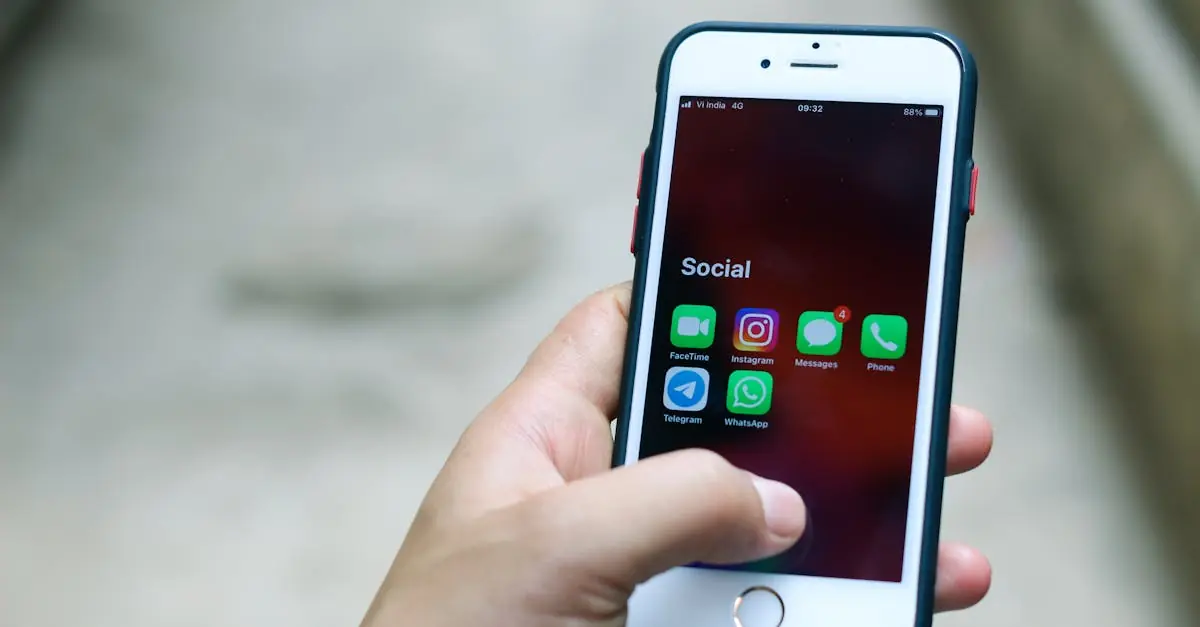Ever hit that dreaded delete button on your iPhone and watched in horror as important messages vanished into the digital abyss? It’s like losing a sock in the dryer—frustrating and completely unnecessary. But don’t worry, retrieving those lost texts isn’t a mission impossible; it’s more like a slightly challenging scavenger hunt with a happy ending.
Table of Contents
ToggleUnderstanding Deleted Messages On iPhone
Accidentally deleting messages on an iPhone often leads to frustration. Many users wonder where these messages go once they’ve been removed. Deleted messages don’t vanish completely; instead, iPhone stores them in a hidden section for a limited time. The Messages app automatically keeps data for 30 days in iCloud backups and device storage.
Retrieval methods exist for those wanting to recover lost texts. Users can check the “Recently Deleted” folder within the Messages app to see if their texts are accessible. It’s crucial to realize that this folder contains messages only for 30 days after deletion. If the messages aren’t there, other options are available.
iCloud backup serves as another recovery method. By restoring from a backup made prior to the deletion date, users can regain texts along with other data. Accessing iCloud settings on the iPhone helps in finding the correct backup.
Third-party data recovery tools also offer solutions. Many programs specialize in retrieving lost texts directly from the iPhone’s memory. Users should select reputable software to ensure data integrity and safety.
Understanding the limitations of recovery methods remains essential. Timeframes and the state of backups significantly impact success rates. Without proper backups, recovering deleted messages becomes difficult. Staying proactive and regularly backing up data can help prevent future message loss.
Methods To Retrieve Deleted Messages
Retrieving deleted messages on an iPhone involves various methods, making the process manageable.
Using iCloud Backup
To retrieve messages using iCloud backup, first ensure the device is signed into the correct iCloud account. Check if a recent backup exists by navigating to Settings, tapping on your name, and selecting iCloud > Manage Storage > Backups. Initiate the restoration by going to Settings, tapping on General, then Reset, and finally Erase All Content and Settings. After the iPhone resets, select the option to restore from an iCloud backup during the setup process. Choose the appropriate backup containing the deleted messages. Complete the restoration, and the messages should reappear, provided they were included in the backup.
Using iTunes Backup
Using iTunes backup to recover deleted messages requires a computer with the latest version of iTunes installed. Connect the iPhone to the computer. Open iTunes, and select the device icon once it appears. In the Summary tab, look for the “Restore Backup” button. Choose a backup dated prior to the deletion of the messages. Click Restore and wait for the process to finish. Ensure the iPhone remains connected throughout. After the restoration, check the Messages app to confirm that deleted messages are recovered.
Using Third-Party Software
Third-party software can also assist in retrieving deleted messages. Numerous options exist, each with different features tailored for data recovery. Download and install a reputable application specifically designed for iPhone data recovery. Connect the iPhone to the computer and launch the software. Follow the on-screen instructions to scan the device for recoverable messages. Many of these applications present a preview of found messages, allowing users to select those they wish to recover. After making selections, initiate the recovery process as instructed in the software.
Verification Of Retrieved Messages
After retrieving messages, verifying their integrity is essential. Users need to check for the consistency of message details. Confirm that timestamps align with the expected timeline, which helps identify if the correct messages are restored.
Reviewing sender information is crucial as well. Ensuring that each message displays the correct contact name or number can prevent confusion. This verification step also confirms that the restoration process functioned properly.
When examining retrieved messages, pay attention to content quality. Confirm that all text and multimedia elements are intact. Users should scroll through the messages to check for any missing elements, ensuring nothing important is overlooked.
Utilizing the “Recently Deleted” folder can aid in verification of messages. This feature provides a snapshot of recently removed messages before permanent deletion. Accessing this folder helps users confirm whether a message appears there, indicating a potential successful retrieval.
Engaging with stored backups requires careful observation. Check the backup date to ensure it is prior to the deletion. Understanding the backup status empowers users to retrieve messages accurately.
Exploring third-party data recovery tools also facilitates verification. Many programs offer previews of recoverable messages, allowing users to review items before restoration. This feature enhances confidence in the retrieval process and improves message accuracy.
Finally, users should consider documenting the retrieval process for future reference. This practice enables users to build a consistent strategy for managing deleted messages. Keeping track of successful recovery methods reinforces a proactive approach to data management.
Tips To Prevent Future Data Loss
Regular backups protect important messages on an iPhone. Users can enable iCloud backup in Settings: tap on their Apple ID, select iCloud, and toggle on “Messages.” This ensures automatic backups, keeping messages secure.
Exploring third-party applications might also benefit users. Various apps specialize in backup solutions for iPhone data, providing additional protection against accidental deletion. Researching trusted options can help safeguard valuable information.
Setting reminders for manual backups provides an extra layer of security. Users should consider making a habit of backing up their devices every month, ensuring the latest data is always saved. This routine can prevent potential data loss due to unforeseen circumstances.
Using messaging apps with built-in recovery options can further enhance protection. Some messaging platforms offer features allowing message recovery or archiving. Choosing such applications can improve data retention and minimize future loss.
Monitoring device storage regularly aids in managing clutter. Storage issues can lead to data mishaps; thus, keeping ample space available encourages the proper functioning of apps. Frequent checks allow users to stay ahead of potential problems.
Avoiding risky app downloads protects devices from malware that could compromise data. Sticking to reputable sources can limit exposure to harmful applications. This practice supports data integrity and message security.
Educating oneself on phone settings enhances user control over data. Familiarity with device configurations allows users to make informed decisions about backups and data management. Improved knowledge offers greater confidence in handling important information on their iPhones.
Retrieving deleted messages on an iPhone can seem daunting but it’s entirely achievable. With options like the “Recently Deleted” folder and restoring from iCloud or iTunes backups, users have several pathways to recover lost texts. Third-party software also offers a viable solution for those who need more flexibility.
After successful recovery, verifying the integrity of restored messages is crucial to ensure all information is accurate and complete. To safeguard against future losses, regular backups and proactive management of data are essential. By following these strategies, users can maintain control over their important conversations and minimize the risk of losing valuable information.


